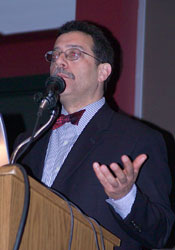
Issues Forum: Key Consumer Markets
Cattlemen explore what motivates consumers in potentially key markets.
 |
| David Coronna, Executive Vice President, Director of Strategy, Burson-Marsteller/USA. |
SAN ANTONIO, TEXAS (Feb. 3, 2005) —The “baby boom” generation is aging, Hispanics represent a rapidly growing segment of the population, and children exert an increasing influence on family food-buying decisions. These trends may represent new marketing opportunities for the beef industry. How the changing U.S. population might affect beef merchandising efforts was explored during a Beef Industry Issues Forum that explained what motivates consumers in these potentially key markets.
The session was one of several issues forums Feb. 3 following the opening session of the 2005 Cattle Industry Annual Convention and Trade Show in San Antonio.
Baby Boomers, most of whom were born during the decade following World War II, represent the largest generation in American history. The 69 million Boomers alive today have been a major influence both socially and economically. They still are. But the early rebellious nature that defined this generation has evolved into an appreciation for moral values.
In general, they are more highly educated and affluent than preceding generations. But they may be less affluent than they expected to be as they cope with later retirement. They have a growing appreciation for comfort foods, but when considering how to reach this important segment of consumers, the beef industry will want to remember that value will be increasingly important to Boomers.
Ranking behind Mexico, the United States is now home for the second-largest Hispanic population in the world. And that population is booming. One out of every seven U.S. residents is Hispanic. Seventy four percent of them immigrated to this country, seeking to improve their economic situation or fleeing political oppression. They like living in the United States, but cling to their ethnic cultures.
Most Hispanics are family-oriented, and food is important — an essential part of routine family gatherings and festivities. They tend to view cooking as a way to pass traditions across generations. Generally, Hispanics are gaining buying power. They spend an estimated $55 million annually for food.
The beef industry should be aware that Hispanics are beef-friendly. Beef purchases represent about $326 per person annually. They favor beef cuts and variety meats that fit their cultural cuisine. They prefer to shop in traditional Hispanic stores offering ethic products. As a food that enhances meal enjoyment, fresh beef fits their style.
A segment of the population that cannot be overlooked is children. The youth market is huge. Today’s youngsters usually have their own money to spend and clear ideas about what they want. As this market evolves, it will be important to understand how youth think and what drives their behavior. They are driven largely by emotion and have considerable influence in family decisions about what and where a family chooses to eat. And the youth of today are the adult consumers of tomorrow. Perceptions about foods, including beef, will color their future buying decisions.
— by Troy Smith, field editor, Angus Productions Inc.
© Copyright 2005 Angus Productions Inc.
Editor’s Note: This article was written under contract or by staff of Angus Productions Inc. (API), which claims copyright to this article. It may not be published or distributed without the express permission of Angus Productions Inc. To request reprint permission and guidelines, contact Shauna Rose Hermel, editor, at (816) 383-5270 or shermel@angusjournal.com.